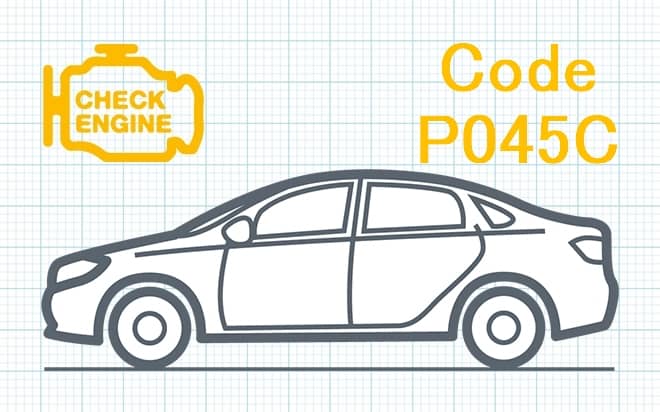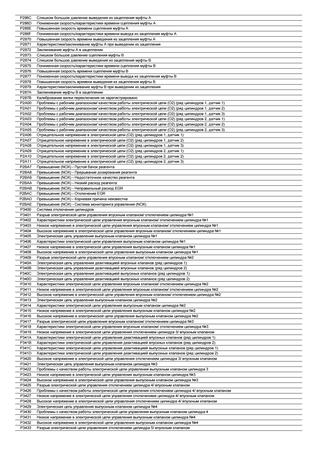
P045C Low Exhaust Gas Recirculation Control Circuit B
Content
P045C Low Exhaust Gas Recirculation Control Circuit B
OBD-II DTC Datasheet
Low signal in the exhaust gas recirculation control circuit "B"
What does this mean?
This Diagnostic Trouble Code (DTC) is a generic transmission code, which means it applies to OBD-II equipped vehicles with EGR. Car brands may include (but are not limited to) Land Rover, GMC, Chevrolet, Dodge, Chrysler, Ford, Toyota, Honda, etc. Although generic, specific repair steps may vary by brand / model.
These engine trouble codes refer to a malfunction in the exhaust gas recirculation system. More specifically, the electrical aspect. The exhaust gas recirculation system is an integral part of the vehicle exhaust system, the function of which is to prevent the formation of harmful NOx (nitrogen oxides) in the cylinders.
EGR is controlled by the engine management computer. The computer opens or closes the exhaust gas recirculation depending on load, speed and temperature in order to maintain the correct cylinder head temperature. There are two wires to the electrical solenoid on the EGR that the computer uses to activate it. The potentiometer is also located in the exhaust gas recirculation solenoid, which signals the position of the EGR rod (the operating mechanism that opens and closes the duct).
This is a lot like dimming the lights in your home. When you turn the switch, the light becomes brighter as the voltage increases. Your engine computer does not see any voltage change when it tries to open or close the EGR, indicating that it is stuck in one position. Codes P045C Exhaust Gas Recirculation Control Circuit "B" indicates no low voltage change, indicating that EGR is opening or closing. P045D is basically identical, but it means circuit high, not low. Consult your specific vehicle repair manual to determine which exhaust gas recirculation circuit “B” is in your particular case.
Unleaded fuel tends to form NOx at extreme engine cylinder temperatures. The EGR system directs a controlled amount of exhaust gas back to the intake manifold. The goal is to dilute the incoming fuel mixture sufficiently to bring the cylinder head temperature below that at which NOx is formed.
The operation of the EGR system is important for more reasons than NOx prevention - it provides more accurate timing for more power without knocking, and a leaner fuel mixture for better fuel economy.
symptoms
Symptoms will vary depending on the position of the EGR needle at the time of failure.
- Extremely rough running engine
- Check engine light is on
- Falling fuel economy
- Decrease in power
- No start or very difficult to start followed by a sharp idle
Possible reasons
Reasons for this DTC may include:
- Short circuit to ground
- Short circuit to battery voltage
- Bad connector with pushed out pins
- Corrosion in the connector
- Dirty EGR needle
- Faulty exhaust gas recirculation solenoid
- Bad EGR
- Defective ECU or computer
Repair procedures
If your vehicle has traveled less than 100,000 80 miles, it is recommended that you review your warranty. Most vehicles carry a 100,000 or XNUMX miles emission control warranty. Second, go online and check all relevant TSBs (Technical Service Bulletins) related to these codes and how to repair them.
To perform these diagnostic procedures, you will need the following tools:
- Volt / Ohmmeter
- Exhaust gas recirculation connection diagram
- Jumper
- Two paper clips or sewing needles
Open the hood and start the engine. If the engine does not idle well, remove the plug from the EGR system. If the engine smooths, the pin gets stuck in the EGR. Stop the engine and replace the EGR.
Look at the wire connector on the "B" EGR. There are 5 wires, the outer two wires feed the battery voltage and ground. The three center wires are a potentiometer that signals to the computer the amount of EGR flow. The center terminal is the 5V reference terminal.
Thoroughly inspect the connector for knocked out pins, corrosion, or bent pins. Inspect the wiring harness carefully for any insulation or possible short circuits. Look for open wires that could open the circuit.
- Use a voltmeter to test any terminal lead with the red wire and ground the black wire. Turn on the key and find 12 volts and both end terminals.
- If the voltage is not displayed, then there is an open wire between the EGR system and the ignition bus. If 12 volts is displayed on one side only, the EGR system has an internal open circuit. Replace EGR.
- Disconnect the connector from the exhaust gas recirculation system and with the key on and the engine off, check both external contacts for power. Write down which one has 12 volts and replace the connector.
- Place a paper clip on the terminal lug that was not powered, this is the ground lug. Attach a jumper to a paperclip. Ground the jumper. A “click” will be heard when the EGR is activated. Disconnect the ground wire and start the engine. Ground the wire again and this time the engine will run rough when the EGR is energized and flatten when ground is removed.
- If the EGR system is activated and the engine starts to work intermittently, then the EGR system is in order, the problem is electrical. If not, stop the engine and replace the EGR.
- Check the center terminal of the exhaust gas recirculation connector. Turn on the key. If the computer is working properly, 5.0 volts is displayed. Turn off the key.
- Refer to the EGR wiring diagram and locate the EGR voltage reference terminal on the computer. Insert a pin or paper clip into the connector on the computer at this point to check the contact back.
- Turn on the key. If 5 volts is present, the computer is OK and the problem is in the wiring harness to the EGR system. If there is no voltage, then the computer is faulty.
Advice for repairing the exhaust gas recirculation circuit without replacing the computer: Look at the wiring diagram and locate the coolant temperature reference voltage terminal. Check this terminal with the included key. If the 5 volt ref. Voltage is present, turn off the key and mark the two support terminals used in these tests. Pull out the computer connector, solder a jumper wire between these two pins. Install the connector and the EGR system will work normally without replacing the computer.
Related DTC discussions
- There are currently no related topics in our forums. Post a new topic on the forum now.
Need more help with a P045C code?
If you still need help with DTC P045C, post a question in the comments below this article.
NOTE. This information is provided for informational purposes only. It is not intended to be used as a repair recommendation and we are not responsible for any action you take on any vehicle. All information on this site is protected by copyright.
